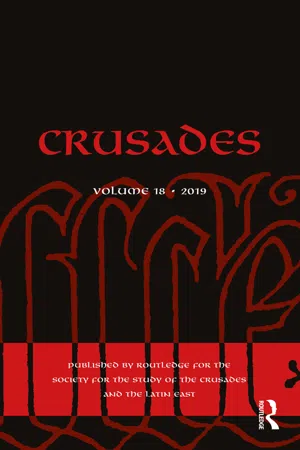
Crusades
Volume 18
- 300 pages
- English
- ePUB (mobile friendly)
- Available on iOS & Android
Crusades
Volume 18
About this book
Crusades covers the seven hundred years from the First Crusade (1095-1102) to the fall of Malta (1798) and draws together scholars working on theatres of war, their home fronts and settlements from the Baltic to Africa and from Spain to the Near East and on theology, law, literature, art, numismatics and economic, social, political and military history.
Routledge publishes this journal for The Society for the Study of the Crusades and the Latin East. Particular attention is given to the publication of historical sources - narrative, homiletic and documentary - but studies and interpretative essays are welcomed too. Crusades also incorporates the Society's Bulletin.
The editors are Professor Benjamin Z. Kedar, Hebrew University of Jerusalem, Israel; Professor Jonathan Phillips, Royal Holloway, University of London, UK; Iris Shagrir, The Open University of Israel; and Nikolaos G. Chrissis, Democritus University of Thrace, Greece.
Frequently asked questions
- Essential is ideal for learners and professionals who enjoy exploring a wide range of subjects. Access the Essential Library with 800,000+ trusted titles and best-sellers across business, personal growth, and the humanities. Includes unlimited reading time and Standard Read Aloud voice.
- Complete: Perfect for advanced learners and researchers needing full, unrestricted access. Unlock 1.4M+ books across hundreds of subjects, including academic and specialized titles. The Complete Plan also includes advanced features like Premium Read Aloud and Research Assistant.
Please note we cannot support devices running on iOS 13 and Android 7 or earlier. Learn more about using the app.
Information
Us and Them: Identity in William of Tyre’s Chronicon
Abstract
Table of contents
- Cover
- Half Title
- Series Page
- Title Page
- Copyright Page
- CONTENTS
- Abbreviations
- Articles
- REVIEWS